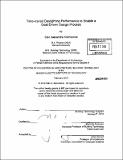| dc.contributor.advisor | Marilyne Andersen. | en_US |
| dc.contributor.author | Kleindienst, Siân A. (Siân Alexandra) | en_US |
| dc.contributor.other | Massachusetts Institute of Technology. Dept. of Architecture. | en_US |
| dc.date.accessioned | 2010-09-02T14:52:13Z | |
| dc.date.available | 2010-09-02T14:52:13Z | |
| dc.date.copyright | 2010 | en_US |
| dc.date.issued | 2010 | en_US |
| dc.identifier.uri | http://hdl.handle.net/1721.1/58173 | |
| dc.description | Thesis (Ph. D.)--Massachusetts Institute of Technology, Dept. of Architecture, 2010. | en_US |
| dc.description | Cataloged from PDF version of thesis. | en_US |
| dc.description | Includes bibliographical references (p. 140-152). | en_US |
| dc.description.abstract | Due to the overwhelming number of decisions to be made during early stage design, there is a need for intuitive methods to communicate data so that it is quickly and easily understood by the designer. In daylighting analysis, research has been moving towards dynamic daylighting metrics, which include both annual performance indicators and local climate conditions. Temporally-based graphics are one method of annual data display which shows great promise for use in the early design stage. Not only can temporal data be easily connected to time-dependent environmental variables like weather and solar angle, but non-spatial quantities related to solar heat gain can be compared on the same terms with spatial quantities like illuminance. This thesis demonstrates methods for quickly calculating annual data sets for which temporal maps are the intended display format. Metrics are then developed in order to display goal-based performance information for an entire area of interest on a single temporal map. This process is demonstrated first by reducing the number of simulations necessary to produce reliable annual illuminance data, the results of which are compiled into a metric based on a user-given illuminance range, known as Acceptable Illuminance Extent (AIE). Similarly, a geometry-based glare approximation method is developed and validated for quick annual calculations of Daylight Glare Probability, and the results are condensed to a single number representative of glare perception within the model, known as Glare Avoidance Extent (GAE). | en_US |
| dc.description.abstract | (cont.) Finally, a simple solar heat gain indicator is demonstrated using the Balance Point calculation method and the metric Solar Heat Scarcity/Surplus (SHS) is used to convey the urgency of allowing more direct solar gain or shading it. This thesis is part of the Lightsolve project, which aims to specifically address the needs of the architect during early design stages. Specifically, Lightsolve aims to produce fast, unique design analyses, based on local annual climate data with reasonably accurate and intuitive outputs to promote good decision-making. Such resources could enable a desirable shift in schematic stage design practices and move daylighting analysis one step closer to achieving "best practice" recognition. | en_US |
| dc.description.statementofresponsibility | by Siân Alexandra Kleindienst. | en_US |
| dc.format.extent | 166 p. | en_US |
| dc.language.iso | eng | en_US |
| dc.publisher | Massachusetts Institute of Technology | en_US |
| dc.rights | M.I.T. theses are protected by
copyright. They may be viewed from this source for any purpose, but
reproduction or distribution in any format is prohibited without written
permission. See provided URL for inquiries about permission. | en_US |
| dc.rights.uri | http://dspace.mit.edu/handle/1721.1/7582 | en_US |
| dc.subject | Architecture. | en_US |
| dc.title | Time-varied daylighting performance to enable a goal-driven design process | en_US |
| dc.type | Thesis | en_US |
| dc.description.degree | Ph.D. | en_US |
| dc.contributor.department | Massachusetts Institute of Technology. Department of Architecture | |
| dc.identifier.oclc | 630656117 | en_US |
